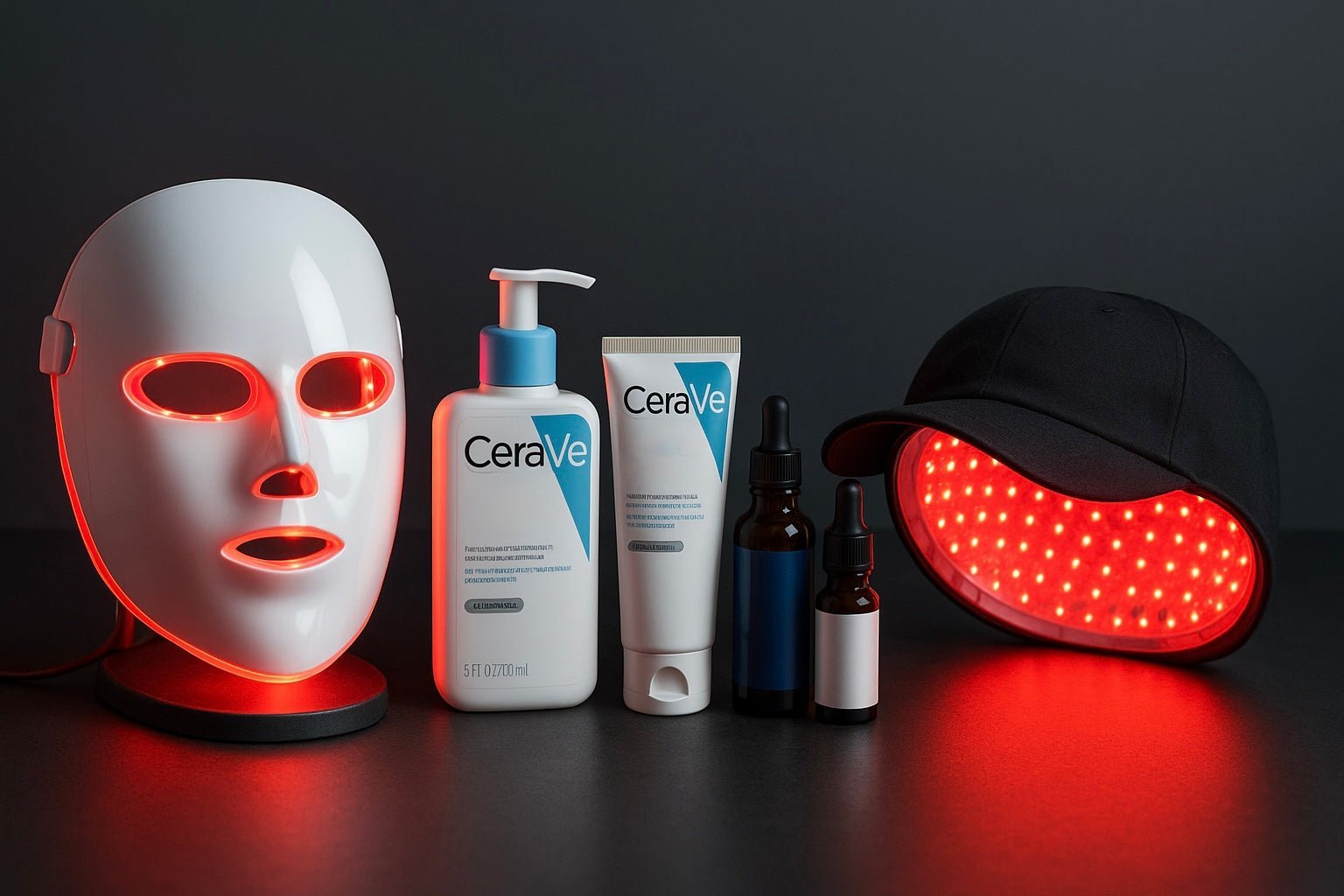Anti-Aging & Longevity in 2025: What It Actually Means – And How To Live It Now

We’re living in one of the most exciting moments in human history.
For the first time, we’re not just talking about aging – we’re measuring it, modulating it, and beginning to slow it down.
We’ve got people like Bryan Johnson showing that you can measurably lower your biological age with a disciplined protocol. It’s not immortality, but it is a real, quantifiable nudge of the clock in the right direction.
At the same time, scientists are studying whales that live over 200 years, discovering supercharged DNA-repair systems that keep their cells young and cancer-resistant. Some of those same mechanisms can already make human cells repair DNA better in the lab.
Put bluntly:
For those of us alive today – in our 30s, 40s, 50s and beyond – it’s realistic to imagine a world where living to 100–120 in good health becomes normal.
And beyond that… we’re crossing into territory no generation has ever seen.
This post is your 2025 longevity field guide:
- What “anti-aging” actually means
- The stack you can implement today
- What we can reasonably expect in the next few decades, if we stay bold and keep pushing
1. What Do We Mean by “Aging” in 2025?
Forget “aging = getting wrinkly and slowing down.”
Modern longevity science treats aging more like software drift and wear-and-tear on hardware:
Chronological vs. biological age
- Chronological age = years on the calendar.
- Biological age = how old your body behaves:
- DNA methylation patterns
- Inflammation levels
- Fitness, strength, VO₂ max
- Brain function and more
-
We now have epigenetic clocks that estimate biological age from DNA patterns. They’re not perfect, but they predict disease and mortality risk better than just your birthdate.
So when someone says they’ve “reversed aging,” what they usually mean is:
“My biological age markers moved in a younger direction.”
That’s not science fiction. That’s already happening in real humans.
The “hallmarks” of aging – and why whales matter
Scientists talk about “hallmarks of aging” like:
- DNA damage and weakened DNA repair
- Epigenetic drift (your cellular “software” gets messy)
- Mitochondrial dysfunction (energy systems wearing out)
- Senescent “zombie” cells that just sit there and inflame everything
- Chronic inflammation and poor protein quality control
Long-lived species like Greenland sharks and bowhead whales handle some of these hallmarks far better than we do. Whales, for example, are insanely good at repairing DNA and preventing cancer.
Human longevity research is basically asking:
“What if we upgrade humans with these same tricks?”
That’s not a metaphor. That’s literally what some labs are trying to do with gene therapy, protein engineering, and cellular reprogramming.
2. The Longevity Stack You Can Implement
Right Now (2025)
Here’s the fun part: you don’t have to wait for gene editing to start living like a future centenarian.
Think of your longevity plan as a stack, from foundations to experimental.
Layer 1: The boring, brutally effective foundations (your base code)
These are the levers that move your risk the most – and set you up to benefit from future breakthroughs.
- Metabolic health = stable internal environment
- Keep visceral fat low (waist size matters more than the scale).
- Aim for healthy fasting glucose, HbA1c, and insulin.
- Golden rules:
- Mostly whole foods
- High-quality protein
- Limit ultra-processed junk and sugar bombs
-
Don’t crush huge meals right before bed
- Movement & muscle = hardware upgrades
- Strength train 2–3× per week (full body, progressive overload).
- Do Zone 2 cardio most days (the pace where you can still talk).
- Add bursts of intensity weekly if your joints and heart are happy.
Muscle isn’t just cosmetic – it’s one of the best “anti-fragility” tools we have against falls, diabetes, and frailty. - Sleep = nightly full-system reboot
- 7–9 hours in a consistent window.
- Dark, cool, quiet room; minimal late caffeine and screens.
- Blue-light blockers + bright morning light to anchor circadian rhythm.
Good sleep touches almost every hallmark: hormones, inflammation, brain detox, learning, mood. - Stress & nervous system = signal vs. noise
- Occasional, controlled stressors (exercise, cold, heat) are good.
- Chronic, unrelenting stress quietly erodes your health.
- Tools that actually help:
- Meditation or breathwork (even 5–10 min)
- Time in nature
- Therapy / honest conversations
-
Deliberate “off” time with no screens
- Relationships & purpose = the human OS
- Loneliness is as bad for health as heavy smoking.
- Deep relationships, feeling useful, working on something that matters – these are biological inputs, not just “nice-to-haves.”
-
If you master just this layer, you’re already doing real-world anti-aging – not in a magical way, but in the sense that your trajectory changes.
Layer 2: Smart supplementation & tech (2025 tools you can actually use)
This is where Forge lives: practical upgrades that enhance, not replace, the basics.
Supplements: the “support crew”
(Not medical advice, just a sketch of what many longevity-focused people gravitate toward.)
Baseline support:
- Vitamin D if your levels are low (very common in northern climates).
- Omega-3 (EPA/DHA) if you don’t eat much fish.
- Creatine for strength, power, and cognitive benefits.
- Magnesium (glycinate or similar) for sleep, nerves, and muscles.
- Collagen + vitamin C for joints, tendons, and skin support.
Cellular energy & repair tier:
- NAD+ precursors (NMN / NR)
- They have a strong mechanistic story: support mitochondrial function, sirtuins, and cellular repair pathways.
- Early human data is promising for metabolic health and energy, but we don’t yet have hard lifespan data.
-
Think of them as “plausible, science-aligned boosters,” not guaranteed extra years… yet.
Mindset:
Use supplements to reinforce a strong lifestyle,
not to paper over a weak one.
Red light therapy (RLT): targeted regeneration
Red and near-infrared light have solid evidence for:
- Skin rejuvenation (collagen, fine lines, texture, wound healing)
- Hair support in androgenic hair loss
- Pain and recovery in some joint and muscle issues
We’re not at “step in the pod and walk out 10 years younger,” but RLT is already a legit regeneration tool for specific tissues. Used consistently, it can be part of a realistic “look and function younger for longer” strategy.
Saunas, cold exposure & wearables: lifestyle tech
- Sauna: Regular use is linked with lower cardiovascular and dementia risk in observational data. It’s like a cardiovascular workout + heat shock therapy for your proteins.
- Cold exposure: Ice baths, cold showers, winter swimming – controlled stress that seems to affect metabolism, brown fat, and maybe even some of the same stress-response pathways whales use.
- Wearables: Oura, WHOOP, etc. give feedback loops on sleep, HRV, and habits. Used wisely, they help you turn your body into a self-improvement project with data.
Layer 3: Medical longevity – using healthcare as proactive tech
This is where you combine classic medicine + longevity mindset.
What we can already do today
Right now, the strongest “anti-aging drugs” are:
- Blood pressure control
- Aggressive lipid management if your ApoB/LDL is high
- Glucose control if you’re prediabetic/diabetic
- Cancer screening (colon, breast, prostate, skin, etc.)
- Not smoking and going very easy on alcohol
Unsexy? Yes.
But these are the levers that stop the three big killers: heart disease, stroke, and cancer. That alone can add years to your healthy lifespan.
Metformin: the OG longevity drug candidate
Metformin is an old diabetes drug with intriguing longevity data:
- Diabetics on metformin often do better than diabetics on other drugs, and in some analyses even similarly or slightly better than matched non-diabetics.
- The TAME trial is testing whether metformin can delay multiple age-related diseases in older adults without diabetes.
Right now:
- It’s clearly useful for insulin resistance and type 2 diabetes.
- Using it purely for longevity in a healthy person is still experimental. Some longevity doctors are cautiously in; others prefer focusing on training, muscle, and lipids instead.
The optimistic angle:
If metformin works even moderately well in TAME, it opens the door for aging to be treated like a targetable medical condition, not an unavoidable destiny.
GLP-1s, SGLT2s & other metabolic game-changers
Newer metabolic drugs (GLP-1 agonists like semaglutide, SGLT2 inhibitors, etc.):
- Dramatically improve obesity and diabetes outcomes.
- Reduce cardiovascular risk in high-risk patients.
They’re powerful indirect anti-aging tools: if we can blunt the epidemic of metabolic disease, we shift an entire generation’s healthspan forward.
3. The Future: What Can We Reasonably Expect in the Next Few Decades?
Here’s where we let the sci-fi optimism breathe, while still speaking in probabilities, not fantasies.
0–10 years: Aging becomes trackable and “tunable”
Coming upgrades:
- Better biomarkers: more precise epigenetic clocks, organ-specific aging scores, AI-based risk models. You’ll know not just how old you are, but how old your heart, liver, or brain looks.
- Smarter drug combinations: treatments that combine anti-inflammatory, senolytic, and metabolic effects in one protocol.
- Mainstream prevention culture: More people treating their 30s, 40s, 50s checkups like “software updates” instead of crisis response.
This decade is about taking control of the dials.
10–20 years: Gene therapy & partial reprogramming start to land
This is where it gets spicy.
Researchers are already:
- Using partial cellular reprogramming in animals (carefully timed pulses of reprogramming factors) to reverse epigenetic age and extend lifespan while trying to avoid cancer.
- Testing longevity-linked gene therapies in early human contexts: things like boosting Klotho, modifying lipid metabolism, or enhancing DNA repair.
- Borrowing ideas from whales and other long-lived animals: tuning stress-response proteins, DNA repair systems, and tumor suppression.
Reasonable 10–20 year outlook:
- Targeted gene therapies that:
- Improve DNA repair
- Boost metabolic resilience
-
Reduce neurodegeneration risk
- Early partial reprogramming therapies for specific tissues (retina, bone marrow, maybe brain regions) in high-need patients, slowly expanding as safety is proven.
If earlier generations invented cars, planes, and spaceflight, our generation’s equivalent might be:
Learning how to periodically “service” the human body at the cellular level.
20+ years: Aging as a managed, chronic process
If we keep pushing and avoid major global disasters, this is the exciting but realistic horizon:
- You get regular full-body scans, multi-omics readouts, and epigenetic age reports as part of normal care.
- Every decade or so, you go through a rejuvenation cycle:
- Senolytics to clear zombie cells
- Targeted gene therapies to fix emerging weaknesses
-
Partial reprogramming pulses to “polish” the epigenetic software in a controlled way
- Healthspan stretching towards 100–120 as a common reality for people who start early and stay engaged.
Will everyone live to 150? Maybe not – at least not at first, and not equally across the world.
But for people alive now who take care of their “house” and ride the wave of new therapies, the ceiling is moving upwards in a way no previous generation has experienced.
4. How To Live Like a Longevity Maximalist
Today
If you want to surf this wave – not watch it pass by – here’s the simple, optimistic strategy:
- Build the best possible baseline body.
- Train, eat, sleep, and recover like someone who expects to use this body for 100+ years.
- Think: “I’m preparing this hardware to run future software updates.”
- Use today’s tools intelligently.
- Supplements, red light, sauna, cold, wearables – great, as long as they support the basics, not replace them.
- Treat them like upgrades, not magic.
- Treat healthcare as proactive tech, not emergency repair.
- Regular blood work, imaging, and screening.
- Serious about blood pressure, lipids, glucose.
- Open, curious conversation with doctors about evolving longevity options.
- Stay curious and optimistic.
- Follow the science.
- Be early, but not reckless: experiment at the edges, monitor, adjust.
-
Remember: every year you stay alive and healthy, you “buy a ticket” to the next wave of breakthroughs.
At Forge, this is our core belief:
You don’t have to wait for the future to arrive.
You can live as if longevity is solvable – and let the future catch up to you.
The tools of 2025 are already powerful. If you use them well, you’re giving your future self – in 2035, 2055, maybe 2085 – the best possible shot at not just more years, but better ones.



